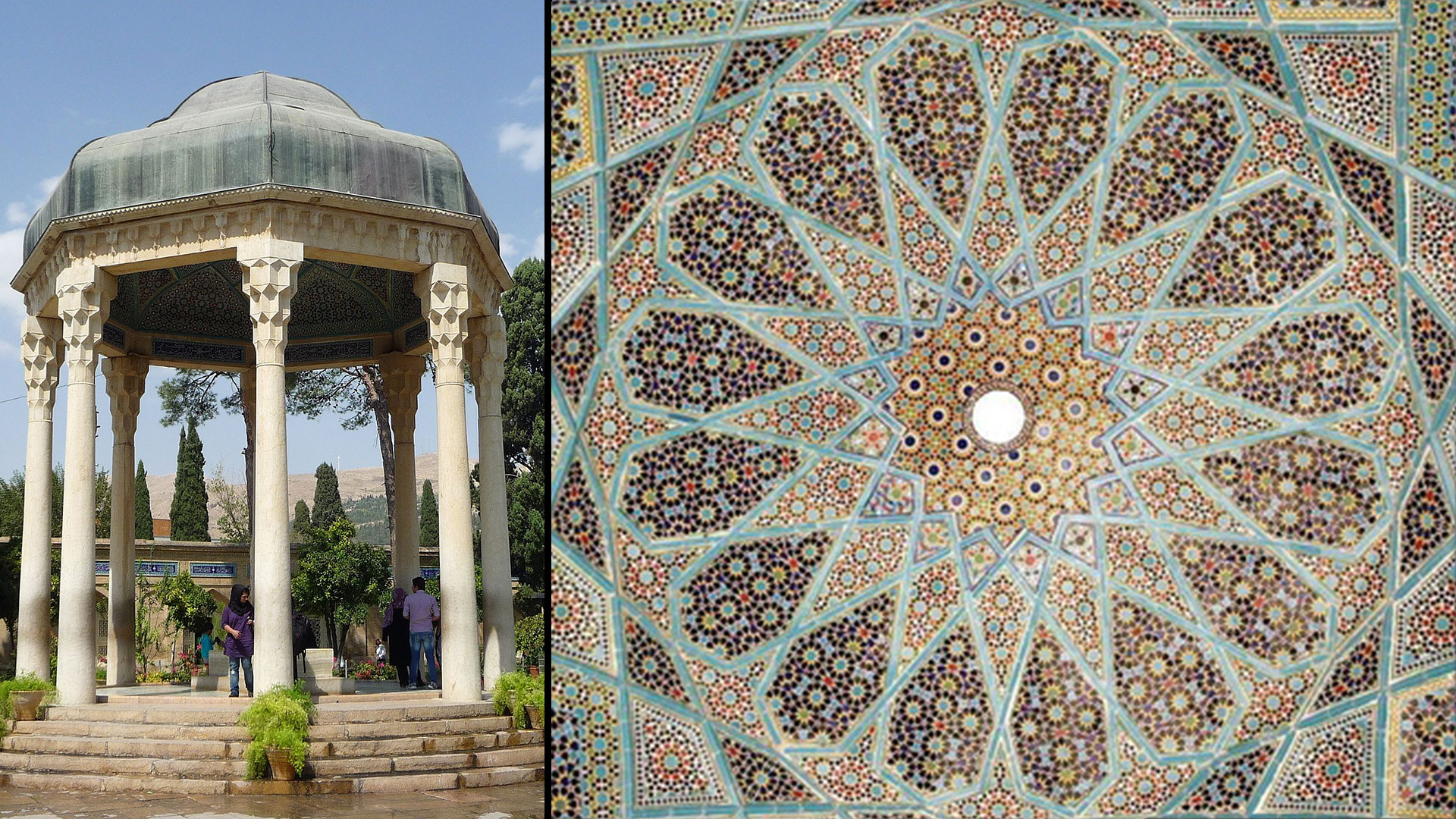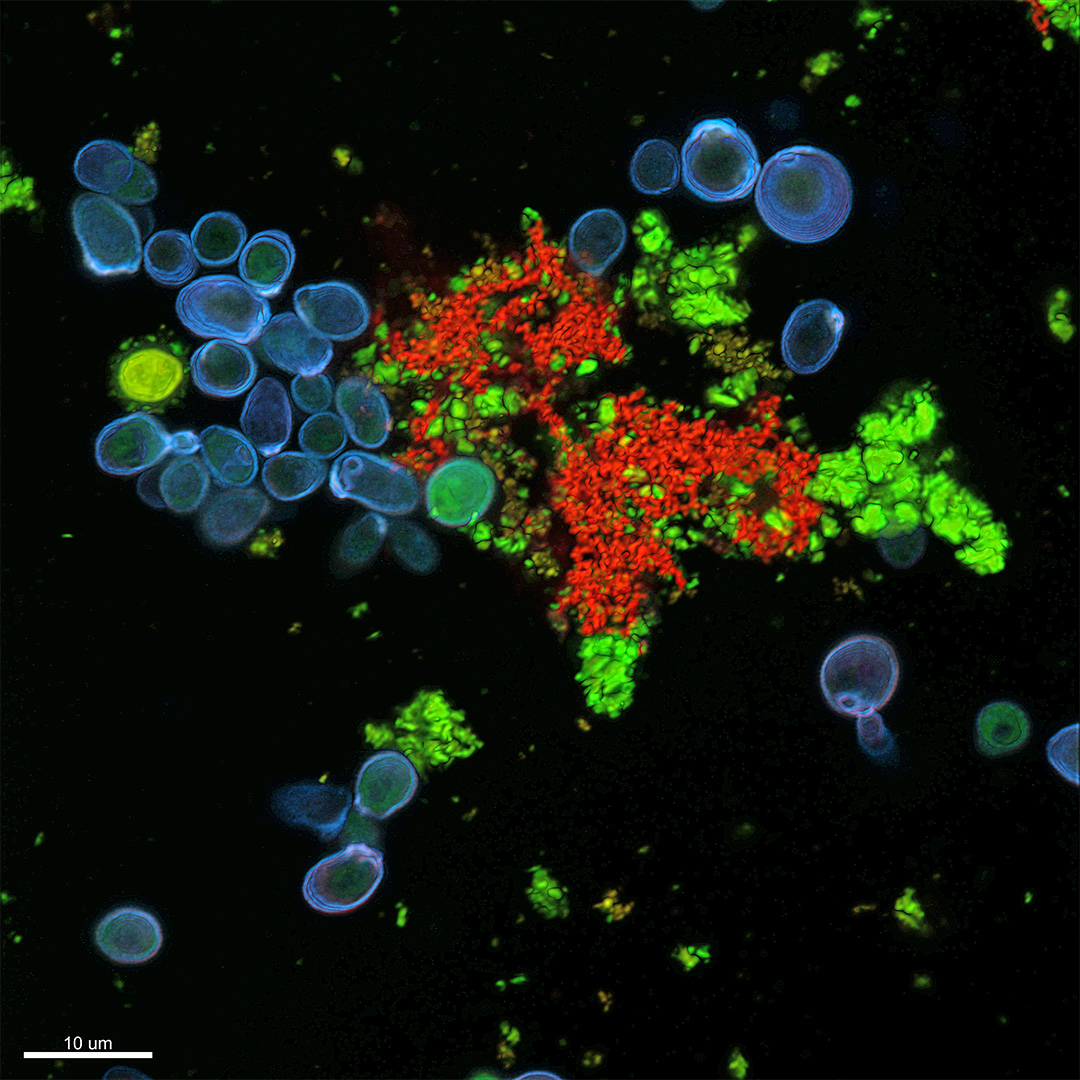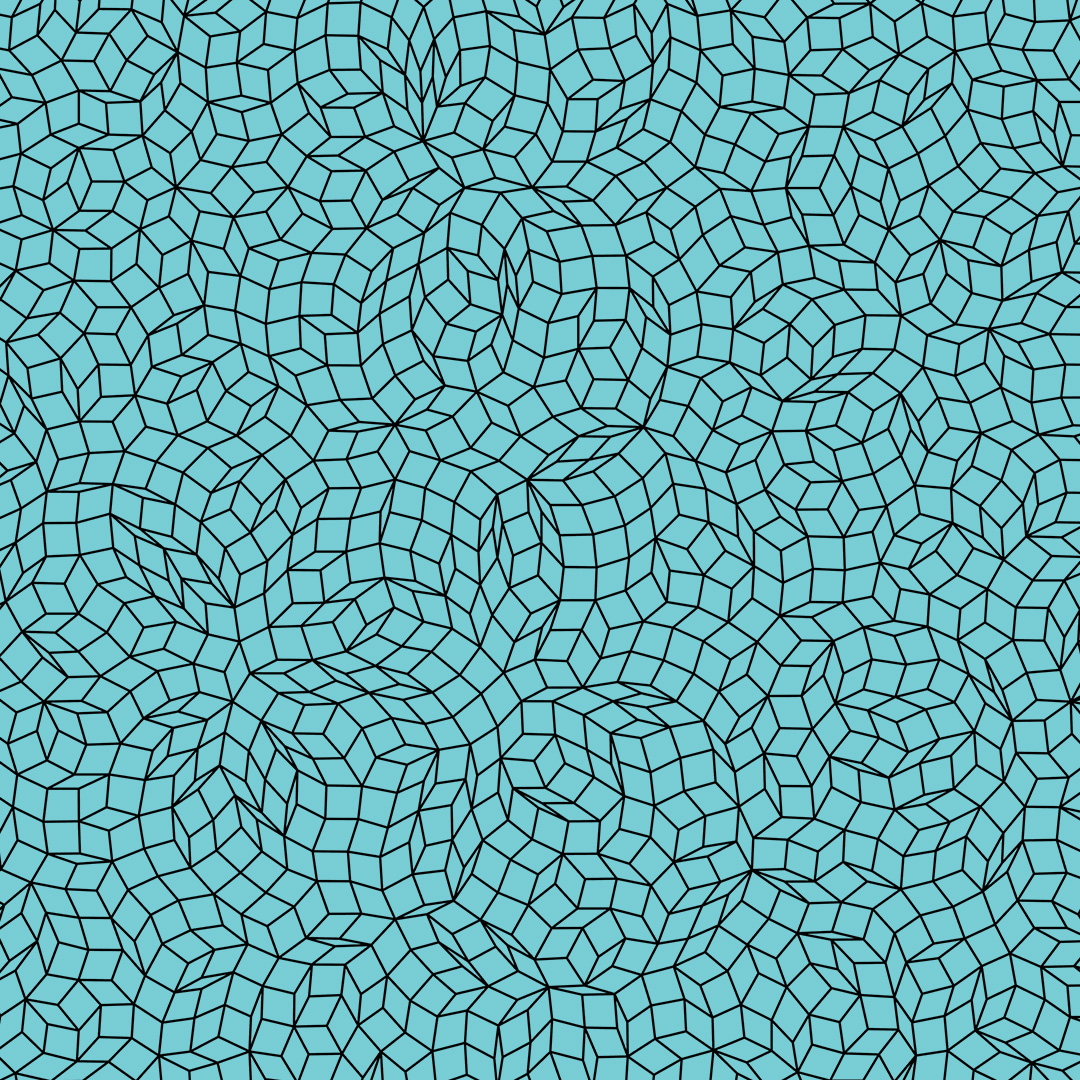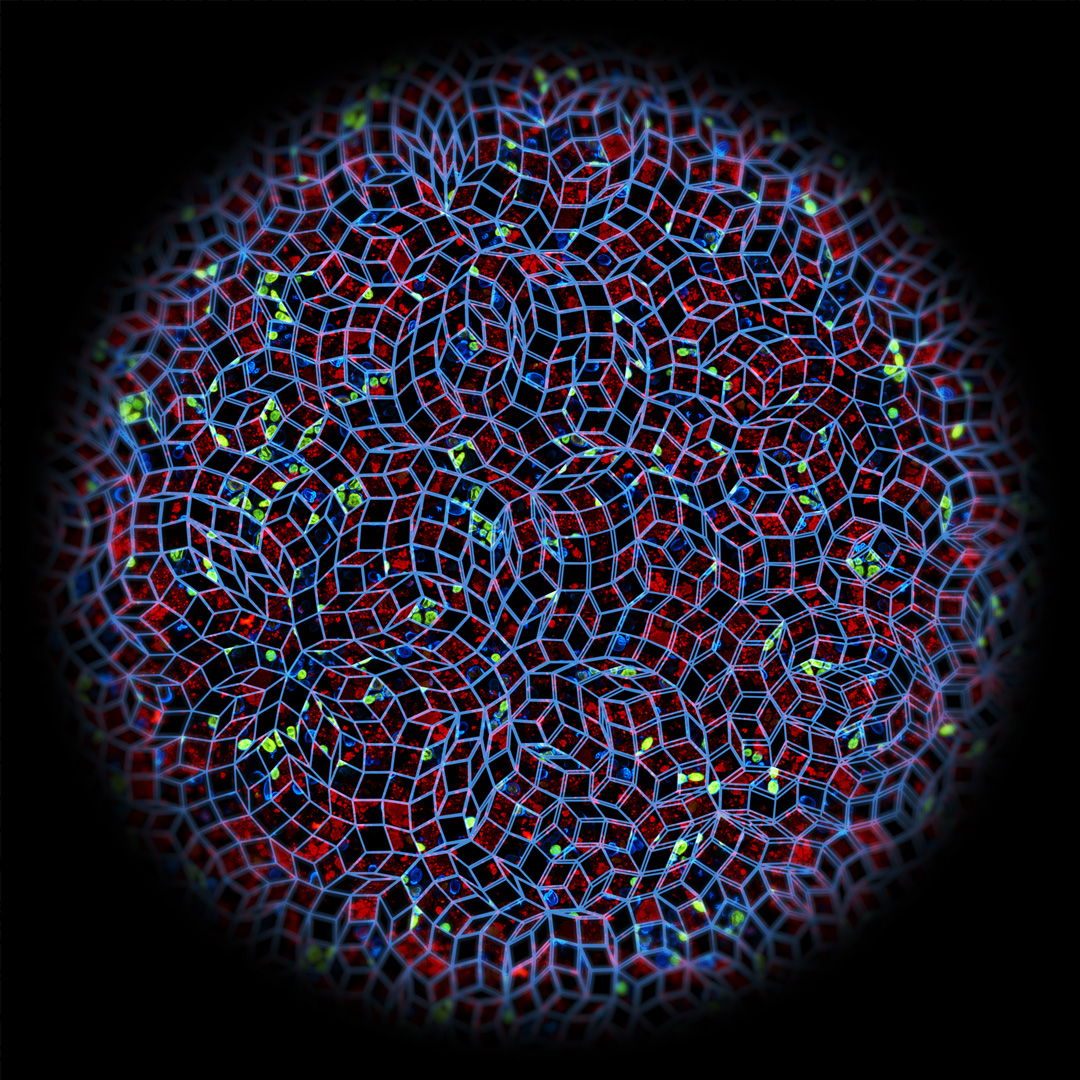Creating Transcendent Space with Projection and Sound
This bioart exhibition installation and live interdisciplinary performance uses sound, poetry, dance, fermentation, DNA augmentation and animation. “Infinite Transformations” is a collaborative project led by Linda Dusman and Foad Hamidi, with the IRC. The audio for the project emanates from a line by the 14th c. Persian Sufi poet, Khajeh Mohammad Hafiz Shirazi. Born in Shiraz (Farsi: شیراز), a desert city in Southern Iran known for its poetry and wine (1315). “never die,” and “one whose heart is vitalized by Love never dies: Our continuity is written on the face of time.” His poetry collection, the Divan of Hafiz, is one of the most popular poetry books in present-day Iran. The poems are typically memorized and recited at significant events such as weddings and new year celebrations today. The calligraphic Farsi characters of the poem are written in ink on the skin of a drum, producing intricate sounds.
During the performance, a bass flute surrounds the audience, summoning the ancient Persian ney and focusing on the breath. The audience experiences a sound that undergoes a reductive filtering process until it is reduced to a near-sine tone, the fundamental building block of all sound. The tone continues to evolve until it transitions from the foundational sine tone to one that accompanies the narrative text.
The poem itself was synthetically inserted into DNA that was able to replicate itself into a yeast for fermenting grape juice into wine. The audience was invited to drink the wine, thereby embodying the 14th century sufi poem. (Khajeh Mohammad Hafiz Shirazi in Farsi: خواجه شمسالدین محمد حافظ شیرازی) who simply used the pen name Hafiz (حافظ).

The Biology of the Wine
The biologically-embodied text is encoded using Morse code, translated into viable genetic code, fabricated, and inserted into the genome of living yeast cells used to make wine. Ambient audio infused the space with the Hafiz poem, which is transformed into timelessness using the resonant frequencies of a room similar to the tomb of Hafiz. The Morse code translation combines with an original bass flute melody tuned to the poetry reading.
From a distance, Persian morse code sounds out the poetry in high-pitched sine tones, reflecting the genetic coding of the yeast DNA that forms the basis of the bioart central to the installation. The melodies fragment and transform as they sound via speakers installed surrounding the space. Through multiple representations, the poem resonates both literally and metaphorically through the meditative space. The scraping sounds of the Persian reed pen ground the continuous calligraph around the wine created from bio-genetically altered yeast (encoded with the Hafiz poetry) in the center of the space.
The steps needed to move from the original poem to the fermenting wine can be broken down into the following stages: (1) converting the poem into a viable DNA sequence, (2) having the DNA sequence synthesized and inserting it into a plasmid (a circular DNA capable of carrying the inserted DNA into cells), (3) transforming living yeast cells using the plasmid and verifying that the yeast cell DNA has incorporated the correct code, and (4) growing the transgenic yeast and using it to ferment grape juice into wine.
Audio Composition
The audio component of Infinite Transformations emanates from the poetry itself, embodying a layering of transformational continuities that “never die.” From a distance, Persian morse code sounds out the poetry in high-pitched sine tones, reflecting the genetic coding of the yeast DNA. The melodies fragment and transform as they sound via speakers installed surrounding the space. Through multiple representations, the poem resonates both literally and metaphorically through the meditative space. The scraping sounds of the Persian reed pen ground the continuous calligraph around the wine in the center of the space.


Projected Imagery

Inverted Ceiling Dome
The ceiling dome is a five-minute looping visual animation projected on the ceiling of undulating geometry and biology that create endless variations of recursive tesellations mimicing the expression in the poetry. The overall structure that defines the physical space of Infinite Transformations is based on a motif of concentric circles, distributed in space from the floor to the inverted dome ceiling. It is inspired, in part, by the tomb of the poet in Shiraz, but also the broader meaning of the circle which connotes wholeness, the cyclical rhythms of nature and the passage of time. It features a table in the center with a large vessel of wine in its center and a projected animation featuring a complex interplay of moving yeast cells and shifting geometric patterns is projected on the curved fabric ceiling. Unlike most domes in buildings designed for spiritual purposes, this dome, formed by a suspended parachute, is inverted, inviting people in, rather than sequestering those already inside. Projected on the table around the wine is a circular video of a skilled calligrapher writing the poem in a circle around the table, over and over again. A schematic drawing of the structure can be found here.
Methods
The source footage was made by the artists from a mixture of live transgenic yeast and wine sediment, which was stained with three fluorescent dyes: acridine orange, calcofluor white, and congo red. Photomicrographs and video were acquired with a Zeiss LSM 900 confocal microscope using 405 and 488 nm lasers and 3 collection windows (blue, green and red wavelengths) and were processed using Huygens (SVI) deconvolution software and Imaris (Oxford Instruments) cell imaging software. The yeast cell images are placed in a circular field where they are animated and integrated with the aperiodic tiling pattern inspired by ancient Persian mosaics. The pattern was doubled and the two instances form moire patterns that ripple across each other as they pass one another. The geometry and biology both talk to endless variation brought about by a shared instruction set—an idea expressed in the poetry
Researchers and Creators
Bioart: Foad Hamidi, Assistant Professor of Information Systems
Music Composition and Sound Art: Linda Dusman, Professor of Music
Recording Engineering and Surround Audio Design: Alan Wonneberger, Director of Recording and Music Technology, Department of Music
Art Direction: Lee Boot, Director of the Imaging Research Center
Animated Imagery: Ryan Zuber, Technical Director of the Imaging Research Center
Choreography and Improvisation: Carol Hess, Professor of Dance and her students (see below)
Cellular Microscopy: Tagide DeCarvalho, Assistant Director, CNMS Core Facilities, College of Natural and Mathematical Sciences
Rigging and Technical Production: Greg Schraven, Technical Director, Department of Theater; Brian Jones, Technical Director, Department of Dance
Biological Consulting: Lisa Scheifele, Associate Professor of Biology, Loyola University
Calligrapher: Laila Kolkabi, Independent Calligraphy Artist
Students
Spatial Design: Fahmida Hossain, Graduate Student, Intermedia and Digital Art
Animation and Motion Graphics: Liza Aleinikova, Graduate Student, Intermedia and Digital Art
Experience Design Research: Lydia Stamato, Erin Higgins, and Hasan Mahmud Prottoy, Graduate Students, Human-Centered Computing
Choreography and Improvisation: Juju Ayoub, Erica Doerrler, Sarah McHale, Joanna Pedro
We would like to thank the Baltimore Underground Science Space (BUGSS), UMBC’s Departments of Theatre, Eve Muson, Department Chair, and Dance, Department Chair
Funding
$24,000. 2022 Imaging Research Center, Faculty Research Fellowship awarded to PIs, Foad Hamidi and Linda Dusman.
Publications, Exhibitions, and Performances
A prototype was presented as an art installation at UMBC’s Performing Arts and Humanities Building from May 22 to 24, 2023.
It was again presented, with the dance component on February 9,10, 2024.
Papers
Stamato, L., Prottoy, H. M., Higgins, E., Scheifele, L., Hamidi, F. 2024. Message in a Bottle: Investigating Bioart Installations as a Transdisciplinary Means of Community Engagement. Accepted, to appear at CHI’2024.
Conference Presentations and Invited Talks
Hamidi, F. 2023. Raaz: Transcendence through Creating Transgenic Poetic Wine. Presentation at Interdisciplinary Conference on Taboo, Transgression, and Transcendence, Malta.
Hamidi, F. Investigating Transdisciplinary Approaches for Community-engagement. Talk at Georgia Tech, Atlanta, GA, November 2023.
Hamidi, F. Community-based Participatory Design Investigating Emerging Technologies. Talk at HCIL, University of Maryland, College Park, MD, November 2023.
Dusman, L. Talk at Conservatorio “G. Nicolini” Piacenza, Italy, March 2023.
Dusman, L. Talk at University of Utah School of Music June 2023.
Dusman, L. Talk at Peabody Conservatory, July 2023.
Dusman, L. Talk at Berklee College of Music, April 2022.